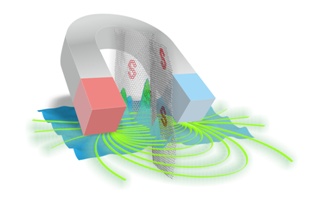Silné feromagnetické uspořádání grafenu indukované dopováním grafenu sírou: Vliv koncentrace a substituční mechanismus
 The doping of foreign atoms of non d- and f-block origin into the crystal lattice of graphene is viewed as promising strategy to induce magnetism in graphene, as demonstrated by both theoretical predictions and experimental observations. It is believed that the magnetic properties of the doped graphene are governed by the chemical nature of the doping element, p- and/or n-type character of the doping element, and doping concentration. Our recent work published in Advanced Materials reports unique magnetic properties induced in graphene by doping with sulfur. It turns out that if the doping of graphene lattice with sulfur exceeds a certain threshold (above 4 at.%), S-doped graphenes show ferromagnetic properties below ~62 K with a saturation magnetization reaching ~5.5 emu g−1, which is among the highest values reported so far for any graphene-based system or even carbon-based (nano)material. Density functional theory computational data proved that sulfur doping induced a ferromagnetic regime only in a narrow concentration window (sulfur content: 4–6 at.%) where the doping-induced paramagnetic centers begin to actively communicate via π–electron system. In particular, the theory shows that the gamma-thiothiapyrone motif of sulfur in the graphene lattice, as magnetically active configurations, is responsible for observed magnetic ordering at low temperatures. The superior magnetic properties of the S-doped graphenes over the N-doped analogs can be explained in terms of injection of two unpaired electrons by each sulfur atom to the conducting band; these electrons are delocalized among the S and C atoms contrary to those injected by N-doping that are dominantly localized at the N sites. The pumping of electrons from substitutional sulfur to the graphene conduction band is also believed to promote the sustainability of the magnetism at relatively high temperatures. It is believed that the controlled sulfur doping represents a huge step toward developing graphene derivatives exhibiting self-sustainable magnetism even at room temperature.
The doping of foreign atoms of non d- and f-block origin into the crystal lattice of graphene is viewed as promising strategy to induce magnetism in graphene, as demonstrated by both theoretical predictions and experimental observations. It is believed that the magnetic properties of the doped graphene are governed by the chemical nature of the doping element, p- and/or n-type character of the doping element, and doping concentration. Our recent work published in Advanced Materials reports unique magnetic properties induced in graphene by doping with sulfur. It turns out that if the doping of graphene lattice with sulfur exceeds a certain threshold (above 4 at.%), S-doped graphenes show ferromagnetic properties below ~62 K with a saturation magnetization reaching ~5.5 emu g−1, which is among the highest values reported so far for any graphene-based system or even carbon-based (nano)material. Density functional theory computational data proved that sulfur doping induced a ferromagnetic regime only in a narrow concentration window (sulfur content: 4–6 at.%) where the doping-induced paramagnetic centers begin to actively communicate via π–electron system. In particular, the theory shows that the gamma-thiothiapyrone motif of sulfur in the graphene lattice, as magnetically active configurations, is responsible for observed magnetic ordering at low temperatures. The superior magnetic properties of the S-doped graphenes over the N-doped analogs can be explained in terms of injection of two unpaired electrons by each sulfur atom to the conducting band; these electrons are delocalized among the S and C atoms contrary to those injected by N-doping that are dominantly localized at the N sites. The pumping of electrons from substitutional sulfur to the graphene conduction band is also believed to promote the sustainability of the magnetism at relatively high temperatures. It is believed that the controlled sulfur doping represents a huge step toward developing graphene derivatives exhibiting self-sustainable magnetism even at room temperature.
Tucek, J.; Błonski, P.; Sofer, Z.; Simek, P.; Petr, M.; Pumera, M.; Otyepka, M.; Zboril, R. Sulfur Doping Induces Strong Ferromagnetic Ordering in Graphene: Effect of Concentration and Substitution Mechanism. Adv. Mater. 2016, 28 (25), 5045–5053. DOI: 10.1002/adma.201600939


